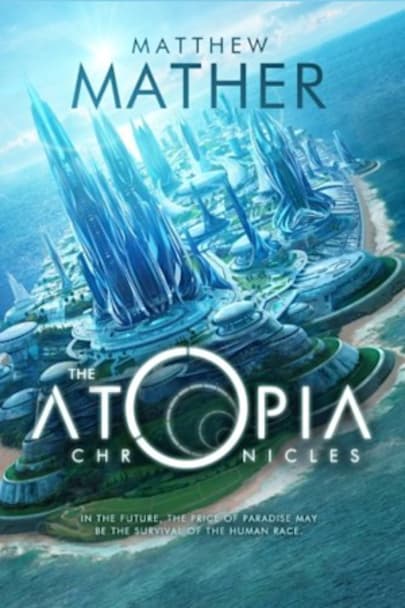What could be worse than letting billions die?
In the near future, to escape the crush and clutter of a packed and polluted Earth, the world’s elite flock to Atopia, an enormous corporate-owned artificial island in the Pacific Ocean. It is there that Dr. Patricia Killiam rushes to perfect the ultimate in virtual reality: a program to save the ravaged Earth from mankind’s insatiable appetite for … to save the ravaged Earth from mankind’s insatiable appetite for natural resources.



The Diagnostic & Statistical Manual of Mental Disorders will need a lot of work
If author Matthew Mather paints an even halfway accurate picture of our future in The Atopia Chronicles, one thing is certain—the Diagnostic and Statistical Manual of Mental Disorders (DSM–5) is going to need a lot of work. First, we’ll need to add the Sim Kid Syndrome, marked by an irrational desire to bring into the world bio-similar digital versions of oneself until your family resembles a small town. Loss of Neural Cohesion results from letting your proxxi drive your body too often. Phuture-Driven Hyperactivity is marked by frenetic action to avoid one’s demise as predicted by the Phuture News (note: more research is needed because these actions may be justified—perhaps the predictions are right).
If you’re thinking that’s a whole truckload of new terminology and technology, you’d be right and there’s a lot more in the book. But in general, all of it is the product of one thing: nanobots that attach to your nervous system (smarticles) so that they can change what you see, hear, feel, taste, and touch. And they can let other synthetic beings (proxxis) act on your behalf because they are, in a sense, you. So, imagine you can live anywhere you want with anyone you want (or at least, a bio-similar copy of that person) during any time period you want while copies of you take care of business. Sound a bit addictive? Sound like it could mess with your mind? And while in the novel this technological revolution is a last-ditch effort to save a dying planet, it parallels some of the current nanobot, virtual reality, and artificial intelligence research. Those similarities are just one of a number of real-world themes raised in the book, making it a very thought-provoking read. I loved that aspect of the work.
But while the book’s provocative concepts are a highlight, there are downsides. First, categorizing the novel in the hard science fiction genre is a bit of a stretch. Parts of its psychology are fantasy—perhaps some medical aspects too, although that’s not my background. Of course, that’s not a problem unless you were expecting hard science fiction. A second concern is that the book is poorly organized. Mather starts with a set of five vignettes that all occur at the same point in time, each from the perspective of a different character. Then, the second half of the book attempts to bring all these threads together. The result is confusing and produces considerable overlap. It’s a 500-page book that probably has 300 pages of story filled with characters that appear, sometimes to reappear, other times not.
While I find the themes in The Atopia Chronicles fascinating and some of them quite probable given the trajectories of today’s research, it was a laborious and often confusing read.
A Wild Ride in Mind Altering Technology. Can this be Humanity’s Salvation?
The world is overpopulated. The only space left is within our minds. And it is limitless. Or is it? The latest innovation, PSSI, gives us a way to expand our world and interact in new ways. But is it everything we are led to believe.
Matthew Mather builds a world like no other. Now you can go where you want, do what you want and even be two places at once. But is this paradise? Matthew’s characters are every bit a real as we are. With some of the very same issues. And perhaps some new ones. Mather’s story leads us on a tortured and confusing trail where the line between reality and imagination becomes blurred. What is real? The answer may not be what you expect.